The most important aspect of the philosophy is that it allows opposites to enter into its purview. This is to say that it is based on a system of opposition. Here I will show 4 contradictory pairs to mention the axioms of Anekantavada. They are:
- Nitya /Anitya (Permanence / Impermanence)
- Asti /Nāsti (Existence / Non-existence)
- Eka /Aneka (One /Many)
- Bheda /Abheda (Different /Identical)
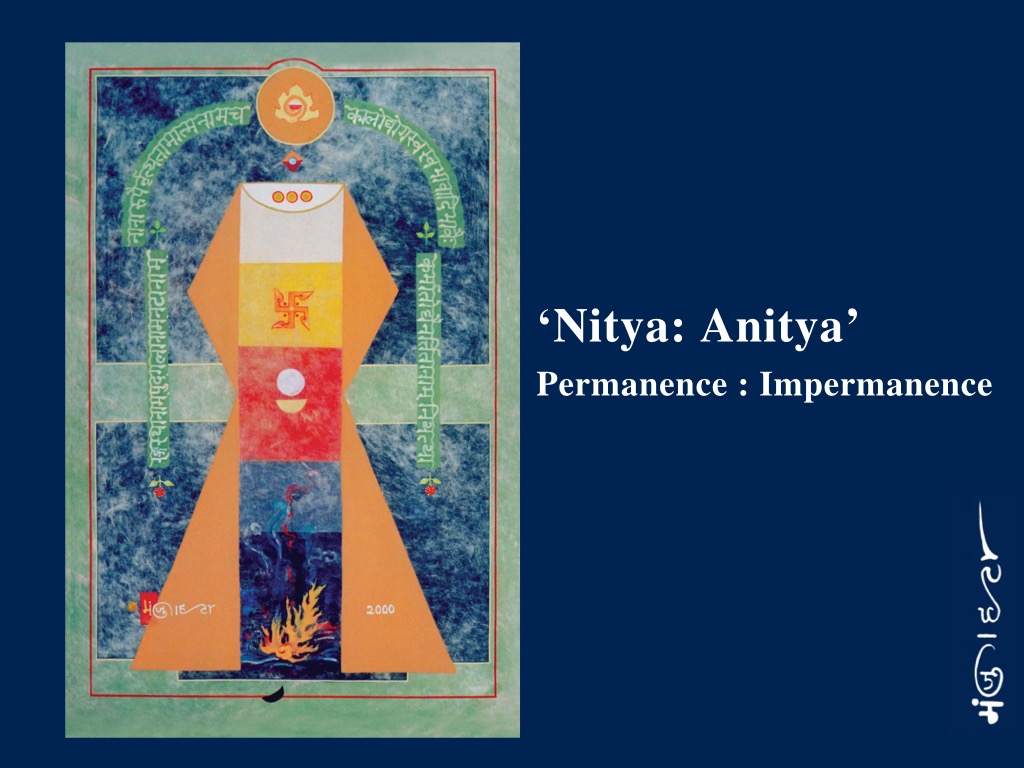
The 1st axiom of non-absolutism is the concomitance of the permanent and the impermanent; the truth of the one is verified by the truth of the other. The logicians concluded that no clear line of demarcation can be drawn between permanence and impermanence.
In Jain philosophy, the word loka has been used for the universe. Please note that no geometrical precision has been taken into account while illustrating the loka. It is just an artist's portrayal of the loka containing its philosophy. Artistic freedom has been taken in the choice of colours, shades and tones.
The shape of the loka or universe resembles a human being standing ramrod straight with hands akimbo and legs a bit stretched. Here a śloka has been painted from Śantasudhārasa which reads:
ra ṅgasthānāṃ pudgalānāṃ natānāṃ, nānārupairnṛtyatāmātmanāṃ ca. kalodyogasvasvabhāvādibhāvaiḥ karmātodyairnarttitānāṃ niyatyā.
The loka is like a stage where all the living beings are actors and dance in various ways and forms. At the top center space, whence the śloka descends rightward and leftward, I have painted an orange circle with the age-old symbol of Om. It contains five flames that stand for the five senses and a red half-moon that stands for mind. The symbol looks like the head of the loka-purusa. Just below the orange circle, at the place of the neck, there is a small Śrī-Vatsa (show) symbol with three colours - orange (for good action), dull red (for evil action), and the bluish-white (for abstinence). We may compare this imaginary shape with what we call Adam's apple.
In accordance with Jain philosophy, the loka is permanent because it has neither origin nor end. Permanence is true because a thing not only exists but exists forever. But in this loka, flow of origination and cessation is also going on without interruption. The old atoms are constantly giving place to new ones. Dravya in its reality can neither be created nor destroyed; it has only permanent substantiality. But through its modes, it secures the triple qualities of permanence, appearance and disappearance.
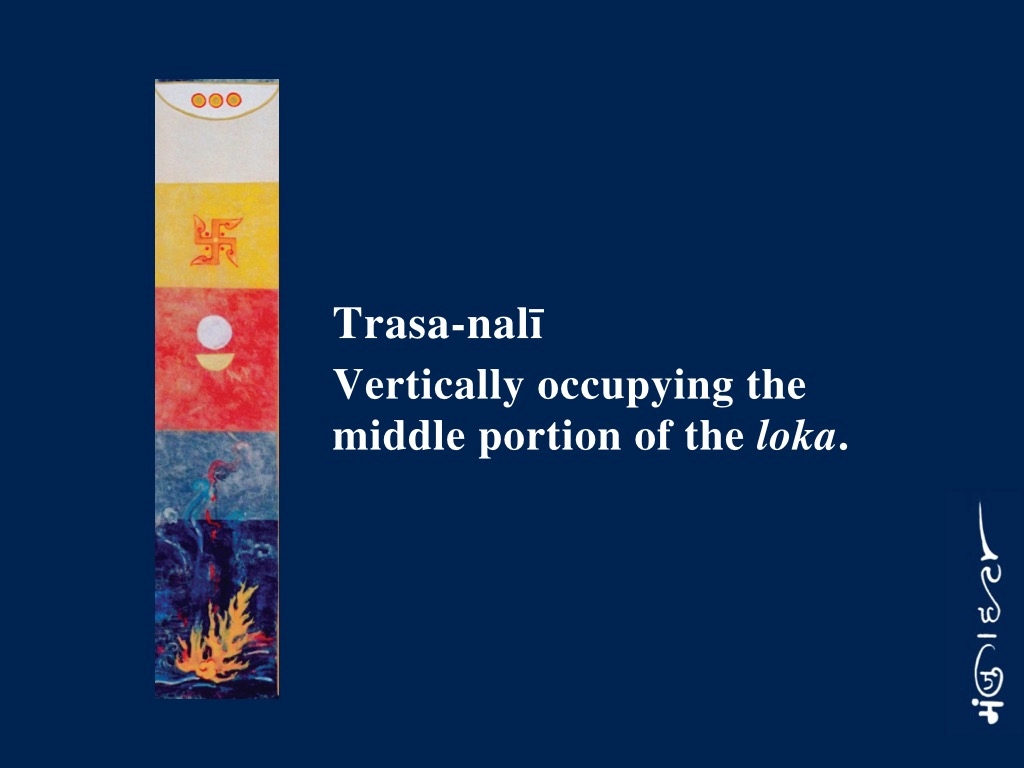
The subtle living beings are all over in the loka, but the trasa living beings (those who can move for their pleasure and pain) are only in the trasa-nalī vertically occupying the middle portion of the loka.
The lower part in white and yellow colours with a symbol of Svastika stands for devasthāna (paradise). The space containing the sun and the half moon is the abode of human beings and animals. This is where the diurnal movements of the Sun and Moon take place. Below it, resides all the seven kinds of hell and is painted in descending order in Blue, Grey and Black. The flames at the bottom section of the loka represent the harrowing of Hell.
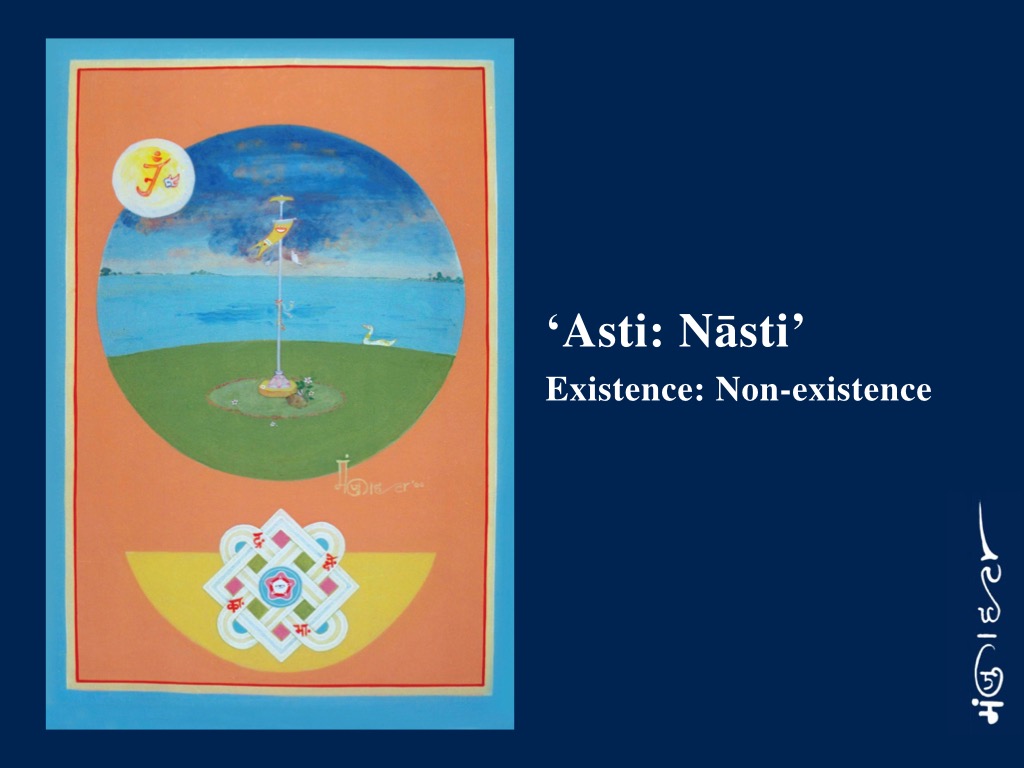
The second axiom of non-absolutism is the concomitance of existence and non-existence, 'Asti: Nāsti'. According to Jain philosophy, the object exists solely with reference to its own substance, space, time, and modes. Here, in this painting we can see a flag and a swan. Both of them have individually different substance, space, time and modes. So, we can say that the 'swan' is not a 'flag' and the 'flag' is not a 'swan'; but the point is that the 'swan' is a 'swan' and the 'flag' is a 'flag' with reference to each one's individual existence. The substance of the flag by which the flag is made, is its own exclusive substance as it exists for and with its own, space, time, colour and shape. Moreover, the place, i.e. where it has been made; the time, i.e. when it has been made; and the mode, i.e. in what colour and shape it has been made - all these factors are to be individually considered for existence of the 'flag'. The intrinsic nature of the substance is the source of existence, while the extrinsic nature of the substance is the source of non-existence. Here, if we take the 'flag' as an 'alien', then from the 'flag's' point of view we find the 'swan' as being 'non-existent' to the 'flag' and vice versa. However, each does exist with reference to its own individual substance, space, time and modes.
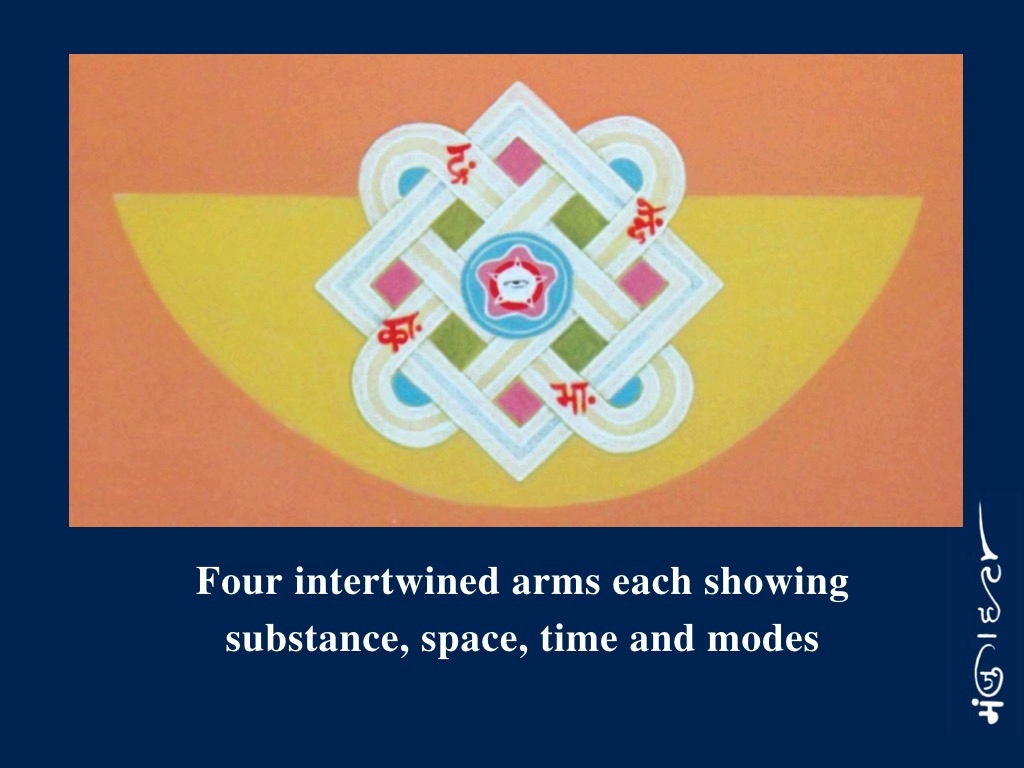
The diagram shown above has four arms intertwined with each other, each showing substance, space, time and modes. These are the four sharply defined aspects to understand any object. There is an 'anekāntic eye' painted in a white circle, which denotes dhrauvya (continuity). The waves, in red colour, that surrounds the white colour depict origination. The circular space, painted in blue and pitted against the waves, stands for destruction. A śloka by Bāṇabhaṭṭa in Kādambarī reads: The white colour is for 'satva' (which shows existence, continuity), the colour red is for rajas showing creation, and lastly, blue is for 'tamas' showing destruction. This, in a way, explains my choosing the colour scheme as painted in the diagram. The characteristic features of what is 'real' are three: creation, destruction and continuity. Whatever is causally efficient does necessarily arise, cease to exist and also continue. The philosophy of non-absolutism made such search and found that existence and non-existence go together. Likewise, 'Affirmation' without 'Negation' and 'Negation' without 'Affirmation' are never possible.
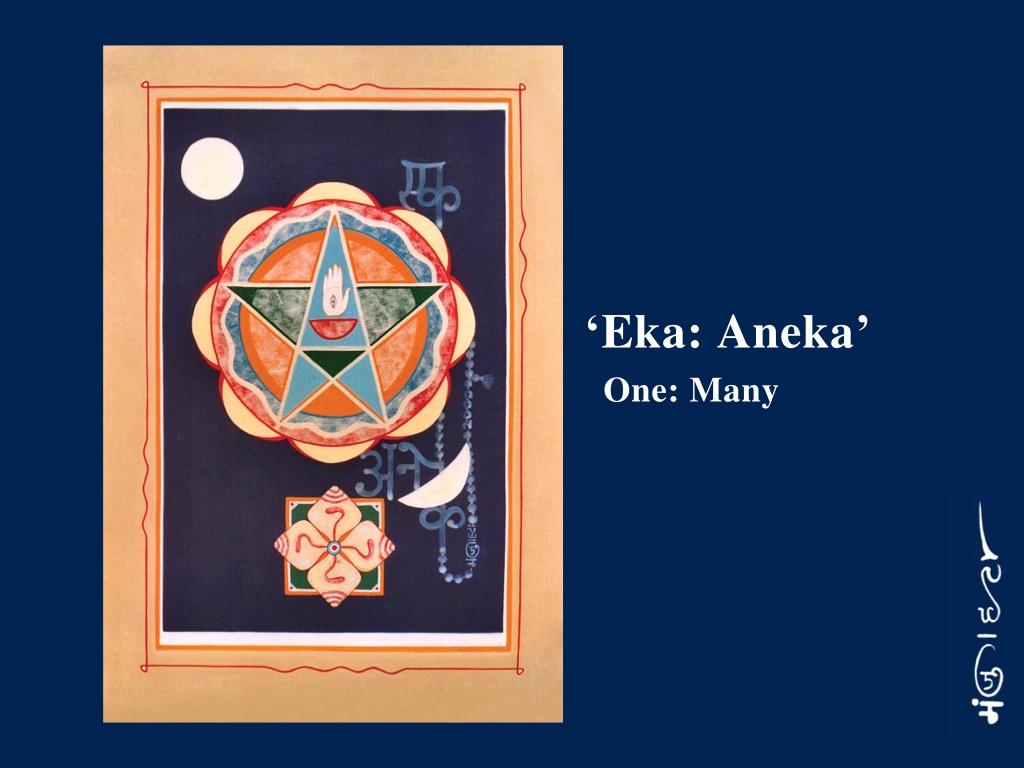
The 3rd axiom is the concomitance of 'one' and 'many'. One is nothing but constituents of parts and, therefore, immutable and eternal, whereas 'many' denotes the ever-changing phases of parts. In fact, as we have noted in the previous axioms, the theme is the interplay of the substance and the modes. The substance is one: the modes are many.
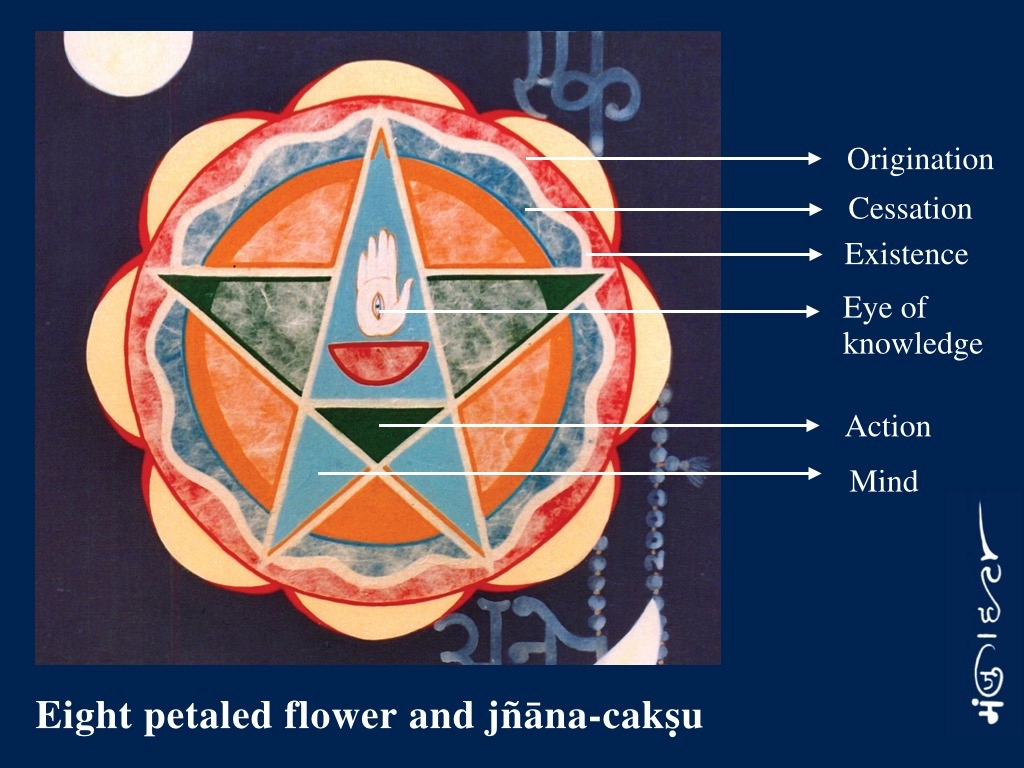
In this painting, there are eight petals of a flower joined to one orange thalamus. In between thalamus and petals, we can see circles in red and blue (standing respectively for origination and cessation, thereby suggesting plurality) with a white wave (standing for existence, unity) in the middle. They show respectively modes and substance.
In the middle of this flower a hand has been painted which has five fingers (denoting plurality) and a jñāna-cakṣu ('eye of knowledge') at the centre of the palm through which we are able to understand the concomitance of one and many. There is, also, a half-red moon standing for our mind. Moreover, we can see an upward-looking arrow (painted in light blue) and a downward thrust dark-green triangle. These 'arrow' and 'triangle' are expressive of two aspects of an individual: mind and action.
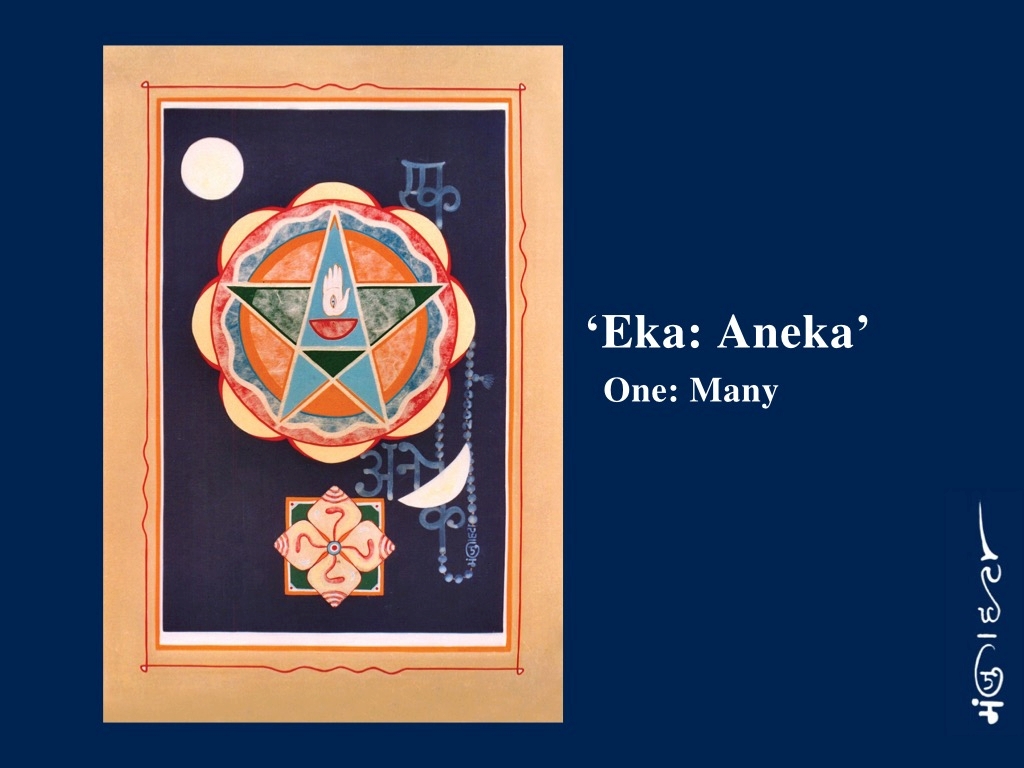
The pattern of four conches shows us the truth that whensoever one makes a sound from any one direction, it echoes in all the four directions. On the right side of the painting, under a white half-moon, a rosary is hanging which has many beads strung in one thread. Furthermore, we can see that the cool soothing light, which we get from the moon, necessarily belongs to the hot bright sun, thus suggesting, in a specific way, the opposites allied to each other. Additionally, at the outer fringe of the painting (in red) an impression is given to the effect that both straight lines and curved lines are, in fact, suggestive of the opposites in alliance.
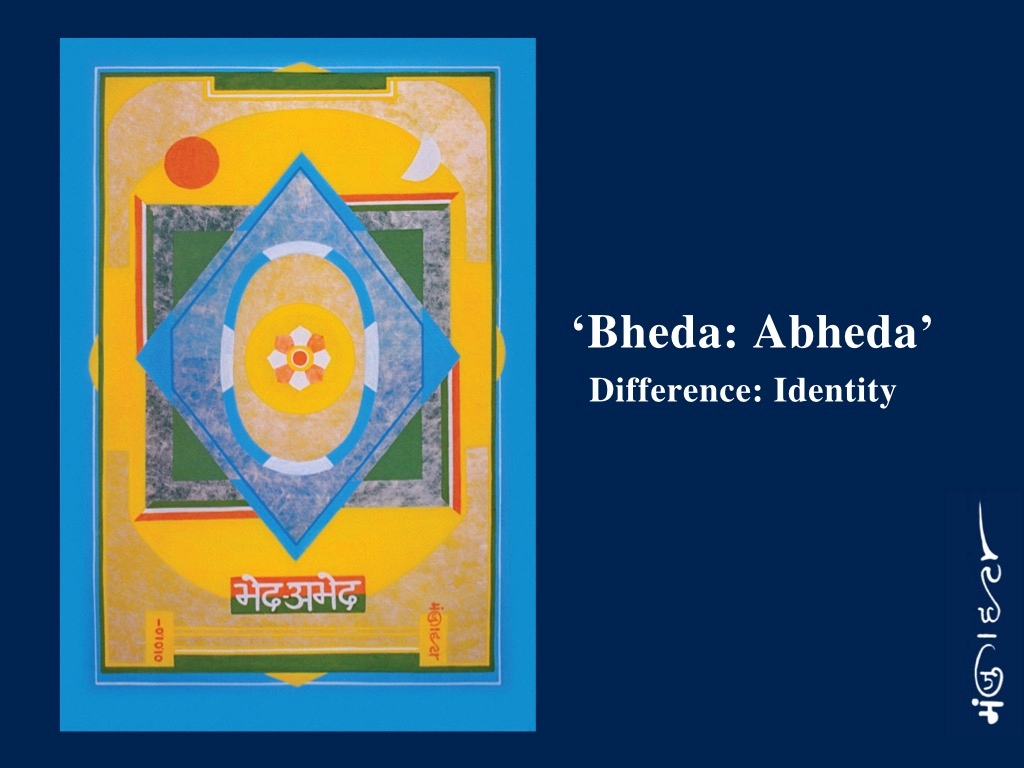
The 4th axiom of non-absolutism is Difference (bheda) and identity (abheda). However, the axiom has at its root the substance and modes, duality.
If, for example, earth is a substance then an earthen pitcher (which functions as a container) is a mode. Thus, though functionally different, both are essentially the same in the sense that there can be no earthen pitcher without earth. In my painting apart from paying attention to the concomitance of 'Bheda-Abheda', I have taken an artist's liberty to pictorially elaborate upon the subject. In so doing I have taken recourse to what is known as Varṇikābhaṅga colour.
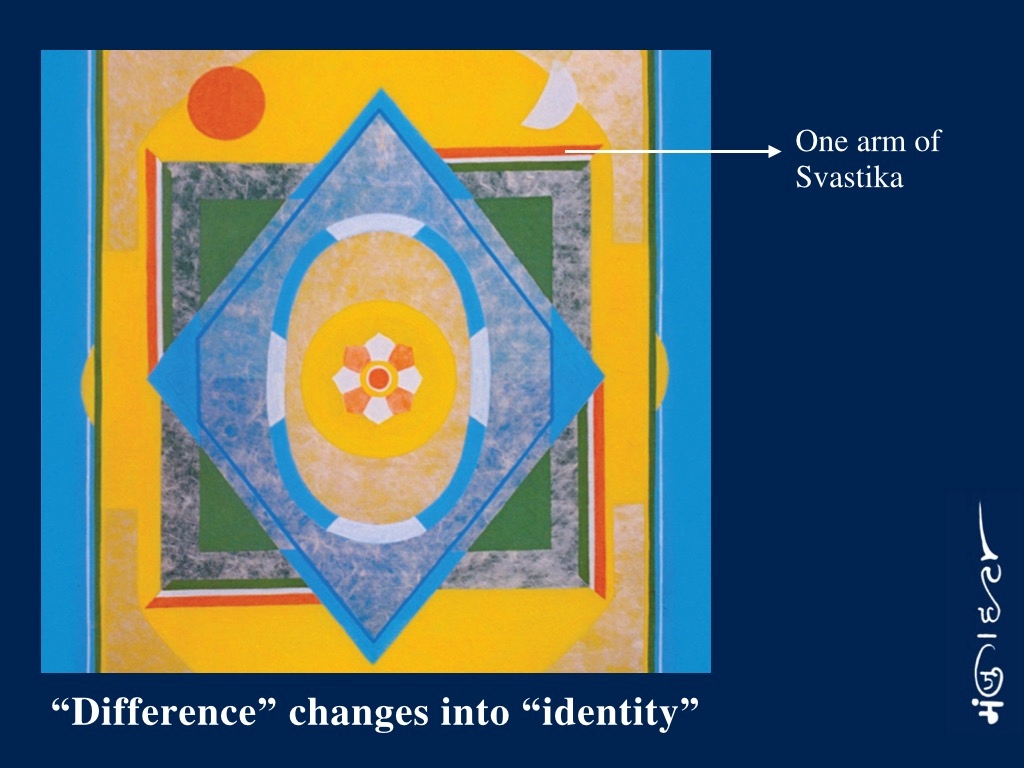
In the middle of the painting there is a yellow circle just outside the flower and there is also a blue Śrī-Vatsa (diamond-shaped). Both of them are painted in two different colours - yellow and blue. These two different colours, yellow and blue, merge together with the result that they look commingled in the green square; thus bheda is transformed into abheda. The central point of the painting is to show how 'difference' changes into 'identity'. Now the 'difference' which we can see in the world is only because of their own karmas.
Moreover, the four arms of Svastika have been painted in the three colours of our national flag to stress the point that if we want to keep the unity of the nation it is quite important to think identically in all the differentiations. In other words, there is unity in diversity. In fine, the four arms of the Svastika are suggestive of auspiciousness realised through identical vision.
As we all know one part of the world is illumined with sunrise, while another is plunged into darkness. But the sun is there in the reflected glory of the moon to dispel the darkness of the night. This natural phenomenon is another beautiful example of 'Bheda / Abheda'.
 Dr. Manju Nahata
Dr. Manju Nahata